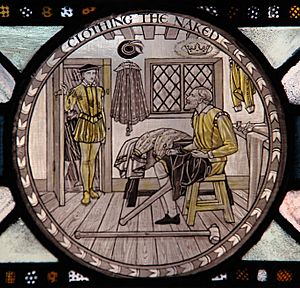Nicholas Horner facts for kids
Quick facts for kids BlessedNicholas Horner |
|
|---|---|

Detail of a stained glass window in Tyburn Convent by Margaret Agnes Rope
|
|
| Martyr | |
| Born | Grantley, Yorkshire, England |
| Died | 3 March 1590 Smithfield, London, England |
| Venerated in | Roman Catholic Church |
| Beatified | 22 November 1987 by Pope John Paul II |
| Feast | 22 November |
Nicholas Horner (died 3 March 1590) was an English Roman Catholic man. He was a tailor, someone who makes clothes. He was put to death because he helped a Catholic priest named Christopher Bales. At that time, it was against the law in England to help Catholic priests. Nicholas Horner is remembered as a Catholic martyr. A martyr is someone who dies for their beliefs. He was officially recognized as "Blessed" in 1987.
Nicholas Horner's Story
Nicholas Horner was born in a place called Grantley in Yorkshire, England. He worked as a tailor, making clothes for people. He traveled to London to get help for a leg injury.
While in London, he was arrested. The charge was that he was helping Catholic priests. He was sent to Newgate Prison. There, he was kept in a small cell for a long time.
He had a heavy chain on his injured leg. He also did not get any medical help. Because of this, his leg became very sick with an infection. Doctors had to remove part of his leg. Another prisoner, a priest named John Hewitt, helped him during this difficult time.
Life After Prison
After about a year, some friends helped Nicholas Horner get out of prison. He started working as a tailor again in Smithfield, London. At some point, he made a type of jacket called a jerkin for a priest.
Later, he was found helping priests again. He was then sent to Bridewell prison. There, he was treated very harshly. He was hung up by his wrists until he almost died.
Final Days
Nicholas Horner was found guilty of a serious crime for making the jerkin for a priest. He also refused to follow the public worship rules of the Church of England. Because of this, he was sentenced to death.
The night before his execution, he had a special dream. He saw a shining crown above his head. He told this dream to a friend. The friend then wrote a letter about it to Father Robert Southwell.
Nicholas Horner was put to death on 3 March 1590. This happened in front of his home in Smithfield.

